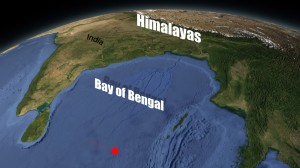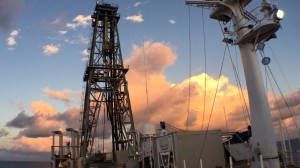25 February 2015
Drilling deep
Posted by Nanci Bompey
By Diane Hanano
This is the latest in a series of dispatches from education officers aboard the JOIDES Resolution, a scientific ocean drilling ship currently on a two-month research expedition in the Bay of Bengal. Read more posts here.
We’re in the Indian Ocean currently drilling the deepest of a six hole transect across the middle of the Bengal submarine fan. The fan covers the bottom of the Bay of Bengal with sediments eroded from the Himalayas. We’ll be devoting almost three weeks of our eight-week International Ocean Discovery Program expedition to drilling at this site. Our target: to reach 1,500 meters (about a mile) depth. Drilling this deep is a major challenge when you are drilling into the seafloor, which just so happens to be more than 3,600 meters (about two miles) below sea level.
But why so deep? And why here?
Answering these questions requires going back a few years. And by a few years I actually mean a few million years. Earth looked very different then – much of Tibet was below sea level and India was down in the southern hemisphere. We know that India slowly drifted northward and eventually collided with Asia. However the timing and nature of this collision, the resulting uplift of the Himalayas and Tibetan Plateau, and the development of the Asian monsoon, are still strongly debated.
By drilling down to 1,500 meters, we are aiming to recover the oldest sediments of the fan that were derived from the early stages of erosion of the Himalayas. If we’re lucky, we might even reach pre-fan deposits. Although to be completely accurate, luck has little to do with it. This particular location was chosen based on years of work by an international team of scientists. The site is located on the western flank of the Ninetyeast Ridge, a prominent topographic feature that rises up from the floor of the Indian Ocean like an underwater mountain chain. As a result, the layers of sediments are thinner here, which means we’ll be able to reach further back in time the deeper we go. Seismic studies have revealed a feature at least ~1,200 meters (0.7 miles) deep that may represent an unconformity – an interval of missing time in the sedimentary record – which would potentially get us back to the Eocene (about 40 million years ago) when Himalayan erosion and fan deposition is thought to have begun.

Map showing the location of the expedition’s six drill sites across the middle Bengal Fan.
Modified from: C. France-Lanord
In these ancient sediments, we’ll be investigating a diverse set of samples ranging from minerals, microfossils and microbes to plant waxes and pore water. Detailed analyses of their physical properties and chemical composition will allow us to address some long-standing questions and to explore the connections between mountain formation and climate. For example, how has uplift of the Himalayas and Tibetan Plateau influenced the monsoon? And how has erosion of these same mountains affected the global carbon cycle?
Many scientific and technical challenges lie ahead, the first of which is to install a re-entry cone and ~400 meters (1,312 feet) of casing to stabilize the upper part of the hole. For the past 24 hours we have been preparing and testing the re-entry system, which is now on its way down to the seafloor. It will be another few days before cores of sediments start arriving on deck, and almost two weeks before we reach our target depth of 1,500 meters. This won’t be simple or fast, much like the processes that formed the Himalayas and the Bengal Fan in the first place.
— Diane Hanano is the scientific coordinator for IODP-Canada and an education officer aboard the JOIDES Resolution.




 GeoSpace is a blog on Earth and space science, managed by AGU’s Public Information staff. The blog features posts by AGU writers and guest contributors on all sorts of relevant science topics, but with a focus on new research and geo and space sciences-related stories that are currently in the news.
GeoSpace is a blog on Earth and space science, managed by AGU’s Public Information staff. The blog features posts by AGU writers and guest contributors on all sorts of relevant science topics, but with a focus on new research and geo and space sciences-related stories that are currently in the news.